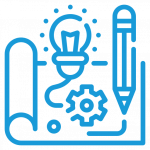Big data migration to the cloud -
3 ways to do it efficiently and achieve goals
Organizations processing large amounts of data face problems such as excessive maintenance costs and administrative problems while struggling to provide resources, coping with uneven workloads on a big scale, and pursuing innovation.
To succeed, it’s worth considering migrating the existing environment to cloud. AWS offers a wide selection of flexible on-demand computing resources, robust and inexpensive permanent storage, and managed services that provide current, known environments for creating and operating big data applications.

Services such as Amazon EMR, Amazon S3 or AWS Glue are an excellent solution, which allows decoupling and scaling of calculations and memory, while providing a highly resistant, integrated and manageable environment, thus eliminating problems in on-premise environments.
SERVICES USEFUL IN THE MIGRATION PROCESS
 Amazon EMR is a service that allows cost-effective and fast processing of large amounts of data. It uses the Hadoop and Spark frameworks based on Amazon EC2 and Amazon S3. It allows for efficient processing of large amounts of data in processes such as indexing, data mining, machine learning or financial analysis. You can find more in our previous blog post.
Amazon EMR is a service that allows cost-effective and fast processing of large amounts of data. It uses the Hadoop and Spark frameworks based on Amazon EC2 and Amazon S3. It allows for efficient processing of large amounts of data in processes such as indexing, data mining, machine learning or financial analysis. You can find more in our previous blog post.
 Amazon S3 is a fully managed extraction, transformation and loading (ETL) service that makes it easier for clients to prepare and load data for analysis. It also allows you to configure, coordinate and monitor complex data flows.
Amazon S3 is a fully managed extraction, transformation and loading (ETL) service that makes it easier for clients to prepare and load data for analysis. It also allows you to configure, coordinate and monitor complex data flows.
![]() AWS Glue is a fully managed extraction, transformation and loading (ETL) service that makes it easier for clients to prepare and load data for analysis. It also allows you to configure, coordinate and monitor complex data flows.
AWS Glue is a fully managed extraction, transformation and loading (ETL) service that makes it easier for clients to prepare and load data for analysis. It also allows you to configure, coordinate and monitor complex data flows.
In addition to AWS services, it is worth using additional open-source tools that together allow you to achieve better results when adapting to the cloud.
OPEN SOURCE SOFTWARE
Apache Hadoop is software for distributed storage and processing of large data sets using computer clusters. Natomiast Apache Spark is a software that is a programming platform for distributed computing. Hadoop is designed to efficiently support batch processing, while Spark is designed to efficiently handle data in real-time. Hadoop is a high-latency computing structure that has no interactive mode, while Spark gives low-latency computing and can process data interactively. Apache Spark is also a component of the Hadoop Ecosystem. Spark’s main idea was to perform memory processing.
 To make the right decision related to infrastructure migration to the cloud, you should first consider the needs of the environment. Consider the issues related to the benefits of using the cloud, which can also help you optimize costs, increase security, and increase architecture performance. Solving the dilemma is not the easiest, but we will help you in the decision-making process.
To make the right decision related to infrastructure migration to the cloud, you should first consider the needs of the environment. Consider the issues related to the benefits of using the cloud, which can also help you optimize costs, increase security, and increase architecture performance. Solving the dilemma is not the easiest, but we will help you in the decision-making process.
3 APPROACHES TO THE MIGRATION PROCESS
There are 3 approaches that will allow you to make conscious decisions about your architecture.
- Re-architecting – it relies on redesigning the existing infrastructure in such a way as to make full use of cloud computing. The approach relies on the analysing the existing architecture and the way it’s being designd, which will allow to provide benefits such as lower memory and hardware costs, increase operational flexibility to ensure business benefits.
- Lift and shift – it is an ideal solution when we need more efficient infrastructure. By transferring the workloads of the existing environment, we can avoid most of the changes that can occur during re-architecting. A smaller number of changes also reduces the risk associated with unexpected work, and thus your solution can come back sooner or enter the market.
- Hybryda – is a combination of two previous approaches. In this mode, the part responsible for fast migration is associated with lift and shift. Re-architecting, in turn, supports the possibilities of redesigning the needed solutions. This approach allows a great deal of flexibility, which allows you to experiment with cloud solutions and gain the necessary experience before you permanently decide to move to the cloud.
PROTOTYPING IN THE SPIRIT OF BEST PRACTICES
 Knowing the migration possibilities to the cloud, let’s move on to prototyping. When learning new solutions, there is always a learning stage. And as you know, practice is its best form. Prototyping should be crucial when implementing new services and products. Here is the scenario the same as before – the cheaper option is to check the application at the prototyping stage. There is a similar story with instance types. The worst assumption is that the application running in the on-premise environment will work the same way in the cloud environment. There are many factors that affect this. It’s worth running applications with loads that can occur in the real world in a test environment.
Knowing the migration possibilities to the cloud, let’s move on to prototyping. When learning new solutions, there is always a learning stage. And as you know, practice is its best form. Prototyping should be crucial when implementing new services and products. Here is the scenario the same as before – the cheaper option is to check the application at the prototyping stage. There is a similar story with instance types. The worst assumption is that the application running in the on-premise environment will work the same way in the cloud environment. There are many factors that affect this. It’s worth running applications with loads that can occur in the real world in a test environment.
So, what are the Best Practices related to prototyping?
- Make a list of all potential assumptions and uncertainties while remembering what may have the greatest impact on the environment.
- First, select and implement the most risky aspects of migration.
- Set your goals in advance and don’t be afraid to ask. The answers will help in project verification or answer the question of how a given solution works.
- Always prototype under similar conditions in which you want to operate. You can start with a smaller environment or set of features and then use the scale.
- Iteration and Continuous Integration as the basis for creating implementation tests. Using an automated environment and scripts, you can run the test in several environments.
- Ask the expert for verification to be able to check the test configuration and environment. This will allow you to eliminate errors and check if the results are not falsified.
- Correctly running the tests will allow you to remove variables that may be due to dependencies.
- Document the test results and ask for verification to ensure they are reliable.
- Don’t take all assumptions for granted! In the big data area, too many factors affect performance, functionality and cost.
- Prototyping aims to verify the assumptions of the project with a fairly high degree of certainty. In general, more effort put into the prototype, taking into account many factors, will give greater confidence that the project will operate in a production environment.
- And above all, don’t be afraid to seek help – from AWS Authorized Partners, AWS Support and in documentation.
HOW TO CHOOSE A TEAM FOR THE CLOUD ADOPTION PROCESS?
Staying in the spirit of best practices, it is also worth paying attention to the right selection of the team members. Each one should understand its role and tasks. Each should have an open mind and an analytical way of thinking. Cloud infrastructure requires a change in the paradigm of how resources are treated. It should focus on the common goal and direction of the project. In particular, they should be able to delve into basic problems, architecture and frameworks.
right selection of the team members. Each one should understand its role and tasks. Each should have an open mind and an analytical way of thinking. Cloud infrastructure requires a change in the paradigm of how resources are treated. It should focus on the common goal and direction of the project. In particular, they should be able to delve into basic problems, architecture and frameworks.
To sum up, the process of migration to the cloud certainly belongs to ambitious projects. However, by choosing the right method of moving the environment, taking into account the best practices and a well-chosen team, we are able to achieve the goals. What’s more – we will gain mobility, security, economy and scalability. The cloud develops in a consistent manner with the needs of customers. Given that this is a trend that brings many benefits – from lower costs to guaranteed data security, and if the cloud adoption process still seems complicated, you should consider the help of an expert who will help you use its potential for 100%.
